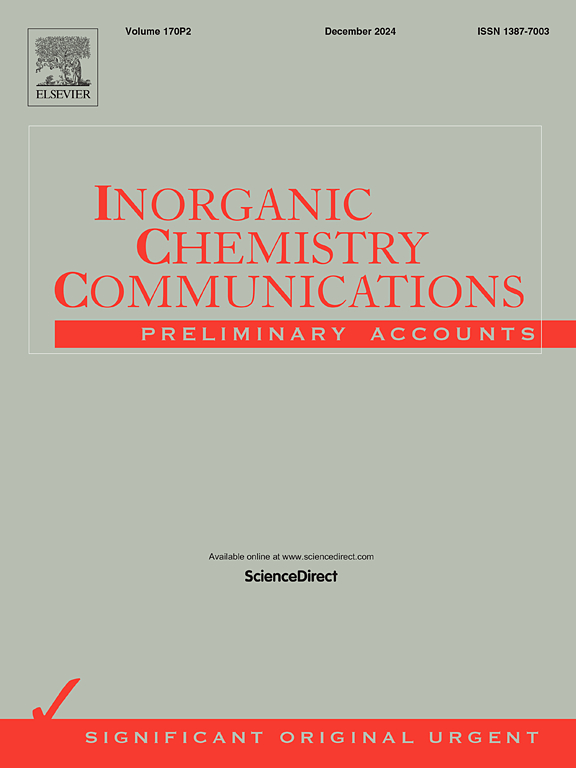Commelina benghalensis-mediated CuO–ZnO nanocomposite: Effect of the p-n heterojunction on the photocatalytic activity against Congo red and carbamazepine
IF 4.4
3区 化学
Q1 CHEMISTRY, INORGANIC & NUCLEAR
引用次数: 0
Abstract
In this study, 30:70 CuO–ZnO nanocomposites (by mass %) were green-synthesised using Commelina benghalensis plant extracts, and their performance for the photocatalytic degradation of Congo Red (CR) dye and carbamazepine (CBZ) were investigated. Fourier-transform infrared (FTIR) analysis confirmed the bond characteristics and the presence of various functional groups within the CuO–ZnO nanocomposite. Structural analysis using X-ray diffraction (XRD) confirmed the presence of tenorite CuO and hexagonal zincite ZnO phases, which were further verified in the CuO–ZnO nanocomposite. The average crystallite sizes were determined to be between 13 nm and 18 nm for ZnO, CuO, and the 30:70 CuO–ZnO nanocomposite, respectively. Scanning electron microscopy (SEM) revealed a mixture of spherical and rod-like morphologies for the 30:70 CuO–ZnO nanocomposites, with a particle size distribution of 2–20 nm. In assessing the photocatalytic performance of the nanomaterials against Congo Red (CR) dye, a 90 % degradation was achieved under optimal conditions of pH 3, a catalyst dosage of 50 mg, a reaction time of 120 min, and a CR concentration of 5 ppm. Furthermore, superoxide ions (O22−) were identified as the dominant species responsible for the degradation of CR. The heterostructure demonstrated reusability, maintaining its effectiveness for up to four cycles. For carbamazepine (CBZ), the 30:70 CuO–ZnO nanocomposites achieved a higher degradation efficiency of 98 %. The nanocomposites were more effective in removing CBZ than CR dye, highlighting their potential for diverse photocatalytic applications.

comelina benghalensis介导的CuO-ZnO纳米复合材料:p-n异质结对刚果红和卡马西平光催化活性的影响
本研究以本品植物提取物为原料,绿色合成了30:70 CuO-ZnO纳米复合材料(质量%),并考察了其光催化降解刚果红(CR)染料和卡马西平(CBZ)的性能。傅里叶红外(FTIR)分析证实了CuO-ZnO纳米复合材料的键特性和各种官能团的存在。x射线衍射(XRD)结构分析证实了纳米CuO - ZnO复合材料中存在tenorite CuO相和六角形锌矿ZnO相,进一步证实了这两种相的存在。ZnO、CuO和30:70 CuO - ZnO纳米复合材料的平均晶粒尺寸分别在13 ~ 18 nm之间。扫描电子显微镜(SEM)显示,30:70的CuO-ZnO纳米复合材料具有球形和棒状的混合形貌,粒径分布在2 ~ 20 nm之间。在评价纳米材料对刚果红(CR)染料的光催化性能时,在pH为3、催化剂用量为50 mg、反应时间为120 min、CR浓度为5 ppm的最佳条件下,降解率达到90%。此外,超氧化物离子(O22−)被确定为降解CR的主要物质。异质结构具有可重复使用性,可维持4个循环。对于卡马西平(CBZ), 30:70的CuO-ZnO纳米复合材料的降解效率达到98%。纳米复合材料比CR染料更有效地去除CBZ,突出了它们在各种光催化应用中的潜力。
本文章由计算机程序翻译,如有差异,请以英文原文为准。
求助全文
约1分钟内获得全文
求助全文
来源期刊

Inorganic Chemistry Communications
化学-无机化学与核化学
CiteScore
5.50
自引率
7.90%
发文量
1013
审稿时长
53 days
期刊介绍:
Launched in January 1998, Inorganic Chemistry Communications is an international journal dedicated to the rapid publication of short communications in the major areas of inorganic, organometallic and supramolecular chemistry. Topics include synthetic and reaction chemistry, kinetics and mechanisms of reactions, bioinorganic chemistry, photochemistry and the use of metal and organometallic compounds in stoichiometric and catalytic synthesis or organic compounds.
 求助内容:
求助内容: 应助结果提醒方式:
应助结果提醒方式:


